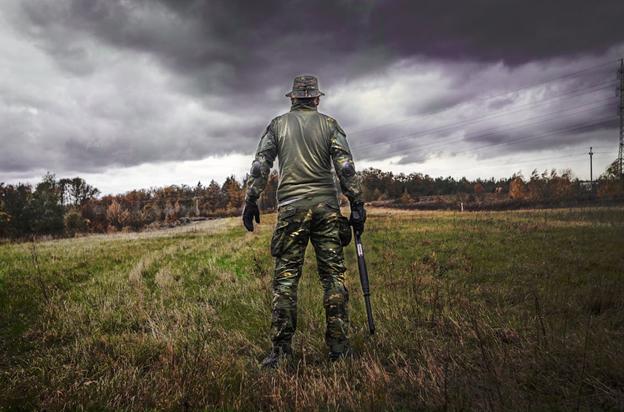Selecting Your Camo Shirt Based on Conditions
Posted by: Fatigues Army Navy Outdoor Gea on 28th Apr 2025
Something that’s funny is some modern hunters really overplay the importance of camouflage. Sure, turkeys and ducks will theoretically see you a mile off if you’re not fully concealed, but concealment is about much more than color or pattern.
What they seem to forget is that stillness and silence are equally as important as visually concealing yourself with an appropriate camouflage pattern. Moreover, they forget that some game, like birds, can see in colors we can’t even see.
Then, consider the fact that mammalian game can and will scent you long before you even have a chance to bust yourself visually.
Anyway, the lesson here is that camouflage is not quite as important as some would have you believe. Let’s not forget that there were effective hunters and sportsmen long before camouflage was even a thing. It is, after all, a relatively modern invention.
All the same, that doesn’t mean camo can’t be your friend in the field. It most certainly can, and being smart about the camo you choose just puts one more wild card in your hand when you’re trying to punch a tag.
So, with that being said, here are the top considerations you need to make when choosing a camo shirt (and the rest of your camo gear) for an upcoming season.
The Ground
The ground is the “average” color the camo shirt appears to be when you look at it from a distance. That is, if you zoom out, what color does the shirt appear to be?
Is it light brown? Tan? Predominantly green? White, as in the case of snow camo patterns?
This is one of the more important aspects of camouflage as, from a distance, blending in with the colors around you can help keep you concealed. In fact, you don’t even need camouflage to illustrate this. Someone in a white shirt will blend into a snowy backdrop better than someone wearing black.
This has less to do with the signal-to-noise ratio that defines camouflage and more to do with contrast. If you wear a camo pattern that is predominantly the same color as your surroundings, you minimize contrast which helps you blend in.
It’s not so effective up close, where signal-to-noise ratio really matters, but at greater and intermediate ranges, it is one of the more effective components to camouflage.
In dry, scrubby woodland, opt for a brown pattern; in the snow, go with something mostly white, and in early fall and late spring, choose a pattern that is shady and green, to help keep you hidden among the leaves.
Macros and Micros
Once you zoom in and see the actual camouflage pattern, then it becomes about concealment.
Your presence sends a signal to potential observers. The more you can interrupt this signal with noise, the harder it gets to detect your presence. Macros and micros, the elements of a camouflage pattern, increase noise.
Macros are the larger elements and micros are the smaller elements. All different camouflage patterns utilize different elements. Some, like Realtree Edge, utilize nearly photorealistic macros and micros. Others, like Mossy Oak Bottomland, rely more on geometric, abstract macros and micros that somewhat insinuate the bark of a tree.
Both patterns can be effective if you align the overall color palette and the macro and micro scheme to your backdrop. For instance, you don’t want a very leafy Mossy Oak pattern in a dry, sandy background. That will actually increase the signal you’re broadcasting by highlighting contrast.
The Game You’re Pursuing
For some game animals, like deer, the color palette of your camouflage doesn’t matter nearly as much as the pattern.
This is because deer, just for example, don’t see colors the way we do. It’s also why you can wear camo-orange, or even just blaze orange, in the deer woods and not get busted.
It’s important to remember this. Blending in is not always about color and sometimes about the pattern.
But, to take this further, let’s not forget that scent control is a much more important aspect of successful deer hunting than visual concealment - though that is a topic for another article.
Pairing Camo in Your Other Gear
You might think that mixing camo patterns is bad news, but generally this is not always the case. There are many camo patterns that complement each other well.
The only time mixing and matching camo patterns is bad is when one of them utilizes a starkly different color pattern than the other. Otherwise, you can pair up a camo shirt with pants in a totally different pattern.
What’s more important than matching patterns is remembering that you can’t let any parts of you “stick out.”

Beyond the Camo Shirt
Following the last statement, there’s no sense in wearing a camo shirt if you’re going to go into the woods with a bright, vibrant, unconcealed pack or boots.
Worst of all are a shiny face and hands. We say shiny because that’s just what it looks like to a duck or a turkey when you don’t cover your face or hands. They shine in the woods or on the marsh like a beacon.
Now, naturally, you have some options here. Wear camouflage gloves to cover your hands. For your face, you could wear a facemask or a hood that keeps you concealed.
Or, as some hunters do, you could just use a bit of charcoal to smudge your cheeks and forehead. That will help keep you concealed.
Get Your Camo Gear Here
Whether you’re here for a camo shirt or need camouflage pants or a pack, we have all the camo gear you need. Keep concealed with game or hostile combatants in paintball or airsoft with the plethora of camouflage gear we carry in our shop, including classic patterns like US Woodland or Tiger Stripe camo.
Take a closer look through our collections today to find what you need and round out your inventory, and if you have any questions about anything we carry, get in touch with us.
